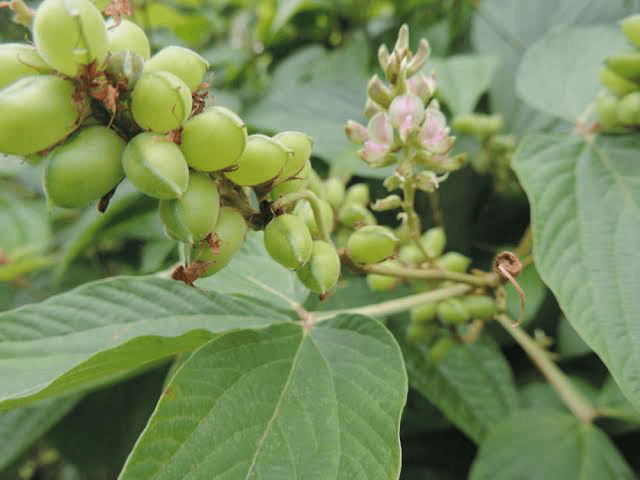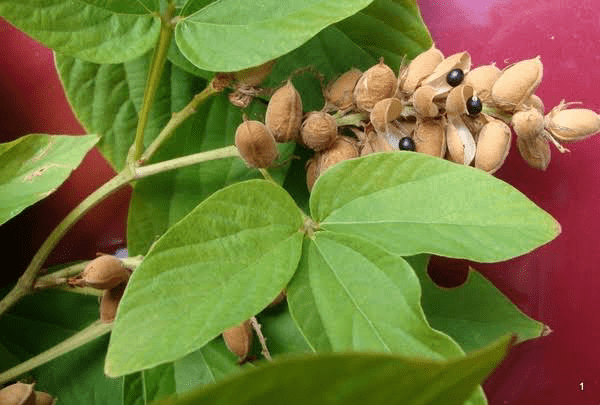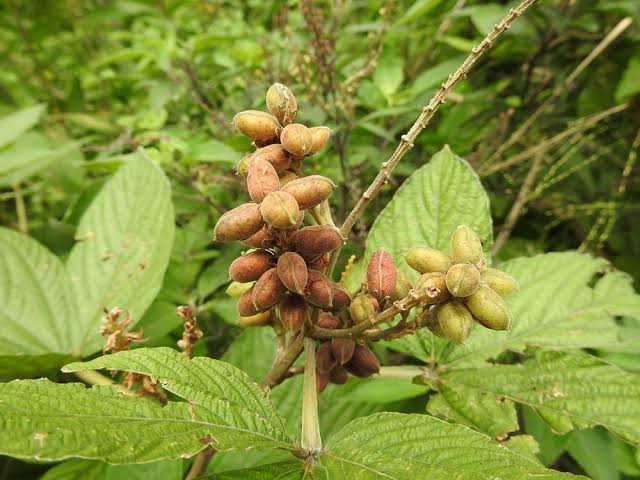Flemingia macrophylla, commonly known as Largeleaf Flemingia, is a versatile medicinal plant with a rich history of traditional use in various parts of the world. This article explores the botanical description, medicinal properties, and historical significance of Flemingia macrophylla.
The Botanical Description of Flemingia macrophylla
Flemingia macrophylla, commonly known as Largeleaf Flemingia, is a versatile medicinal plant with a rich history of traditional use in various parts of the world. Understanding its botanical characteristics is essential for recognizing and utilizing this valuable plant effectively. Here, we provide a detailed description of its botanical features:
1. Family and Genus: Flemingia macrophylla belongs to the Fabaceae family, which is commonly known as the legume or pea family. It is part of the Flemingia genus, which includes several species known for their medicinal properties.
2. Morphological Characteristics: Largeleaf Flemingia exhibits the following morphological features:
i. Leaves: The leaves of this plant are pinnate, alternate, and compound, consisting of multiple leaflets. The leaflets are usually broad and lanceolate in shape.
ii. Flowers: Flemingia macrophylla produces attractive and showy flowers that come in various colors, including shades of pink, purple, or white. These colorful blooms make it an ornamental plant in addition to its medicinal uses.
iii. Fruits: After flowering, Largeleaf Flemingia forms pods that contain seeds. These pods are typically elongated and can vary in size and color depending on the specific variety.
3. Growth Habit: Largeleaf Flemingia is a perennial shrub that can reach heights of up to 2 meters (approximately 6.5 feet). It often displays a bushy or spreading growth habit, creating a dense canopy of foliage.
4. Distribution: This plant species is native to regions of Southeast Asia, including countries like India, Indonesia, Malaysia, and Thailand. Due to its beneficial properties, it has also been cultivated in other parts of the world with suitable climates.
5. Environmental Adaptability: Flemingia macrophylla is known for its ability to thrive in a variety of environmental conditions. It can grow in tropical and subtropical climates and is often found in areas with well-drained soils.
6. Traditional Uses: Throughout history, Largeleaf Flemingia has been used in traditional medicine systems like Ayurveda and Traditional Chinese Medicine (TCM). It has been employed to address various health concerns, including digestive issues, respiratory conditions, and skin problems.
7. Cultural Significance: In certain cultures, Flemingia macrophylla holds cultural and ritualistic significance. It is sometimes used in religious ceremonies and festivals.
8. Potential for Agroforestry: Beyond its medicinal uses, Largeleaf Flemingia has gained attention for its potential in agroforestry systems. Its nitrogen-fixing properties can enhance soil fertility and benefit other crops.
The Geographic Distribution of Flemingia macrophylla
Flemingia macrophylla, commonly known as Largeleaf Flemingia, exhibits a diverse geographic distribution, thriving in various regions around the world. Understanding its geographic range is essential for both cultivation and the preservation of this valuable plant. Here, we list and explain the geographic distribution of Flemingia macrophylla:
1. Native Range: Flemingia macrophylla is native to several countries in Southeast Asia, including:
i. India: Largeleaf Flemingia is found in various regions of India, especially in the northeastern states like Assam and Manipur.
ii. ndonesia: It is also native to parts of Indonesia, particularly in the western region of Sumatra.
Malaysia: Largeleaf Flemingia is naturally distributed in Malaysia, where it grows in diverse habitats.
Thailand: In Thailand, this plant can be found in both wild and cultivated forms.
2. Cultivation Beyond Native Range: Due to its medicinal and agricultural value, Largeleaf Flemingia has been cultivated in regions outside its native range. It is grown in countries like Vietnam, Cambodia, and Laos, where it has adapted well to local conditions.
3. Tropical and Subtropical Regions: Largeleaf Flemingia thrives in tropical and subtropical climates. It prefers areas with well-drained soils and adequate rainfall.
4. Adaptation to Different Climates: One of the remarkable features of this plant is its adaptability to a wide range of climates. It can be grown successfully in regions with diverse temperature and precipitation patterns.
5. Agroforestry Systems: Largeleaf Flemingia is often integrated into agroforestry systems, where it contributes to soil improvement and provides valuable forage for livestock.
The Chemical Composition of Flemingia macrophylla
The chemical composition of Flemingia macrophylla, also known as Largeleaf Flemingia, is a key factor contributing to its medicinal and nutritional value. Here, we list and explain the primary chemical components found in this plant:
1. Alkaloids: Largeleaf Flemingia contains various alkaloids, including sparteine and lupanine. These alkaloids may contribute to its pharmacological properties, such as its potential as a muscle relaxant.
2. Flavonoids: Flavonoids are a group of bioactive compounds found in Largeleaf Flemingia. They have antioxidant properties, which can help protect cells from oxidative stress and reduce the risk of chronic diseases.
3. Triterpenoids: Triterpenoids are secondary metabolites present in the plant. They have been studied for their potential anti-inflammatory and antioxidant effects.
4. Amino Acids: The plant contains essential amino acids, which are the building blocks of proteins. These amino acids are valuable for nutrition and may contribute to its traditional use as a food source.
5. Saponins: Saponins are natural compounds known for their foaming properties. They are often used in traditional medicine and may have potential health benefits.
6. Vitamins and Minerals: Largeleaf Flemingia is a source of vitamins and minerals, including vitamin C, vitamin A, and calcium. These nutrients contribute to its dietary value.
7. Fiber: The plant contains dietary fiber, which can aid in digestive health and promote a feeling of fullness when consumed.
8. Nitrogen-Fixing Properties: Largeleaf Flemingia has the ability to fix atmospheric nitrogen with the help of symbiotic bacteria in its roots. This nitrogen fixation enhances soil fertility, making it valuable for sustainable agriculture.
The Harvesting and Processing of Flemingia macrophylla
The harvesting and processing of Flemingia macrophylla, commonly known as Largeleaf Flemingia, are essential steps in utilizing this plant for its various purposes, including traditional medicine and agriculture. Here, we list and explain the key aspects of harvesting and processing Largeleaf Flemingia:
1. Harvesting Time: The ideal time for harvesting Largeleaf Flemingia depends on the intended use. For medicinal purposes, leaves and aerial parts are often harvested when the plant is in the flowering stage. For forage and agricultural use, harvesting may occur when the plant has reached a suitable height and maturity.
2. Pruning: Proper pruning is essential to encourage bushy growth and to prevent the plant from becoming too leggy. Pruning is often done during the growing season to stimulate new growth.
3. Drying: After harvesting the aerial parts, they are typically dried in the shade to preserve their medicinal properties. Proper drying helps prevent mold or decay.
4. Seed Collection: If seeds are the primary target, they are collected from the pods after the plant has finished flowering and the pods have matured. The seeds are then processed for various uses, including culinary and oil extraction.
5. Processing for Traditional Medicine: In traditional medicine systems like Ayurveda and Traditional Chinese Medicine (TCM), Largeleaf Flemingia may be processed into various forms, including powders, decoctions, or herbal formulations.
6. Agricultural Use: Largeleaf Flemingia is often incorporated into agroforestry systems, where it serves as a nitrogen-fixing cover crop. It can be incorporated into the soil or used as mulch to improve soil fertility.
7. Sustainable Practices: Sustainable harvesting and processing methods are essential to ensure the long-term availability of Largeleaf Flemingia and to protect its natural habitat.
8. Quality Control: When processing Largeleaf Flemingia for medicinal or culinary use, quality control measures are important to ensure the final product meets safety and efficacy standards.
Read Also: Ageratum Flowers (Floss Flower) – All you need to know
The Medicinal Health Benefits Of Flemingia macrophylla (Largeleaf Flemingia)

Flemingia macrophylla, commonly known as Largeleaf Flemingia, offers a wide array of medicinal health benefits owing to its rich chemical composition and traditional use in various herbal medicine systems. Here, we list and explain the notable medicinal health benefits of Largeleaf Flemingia:
1. Anti-Inflammatory Properties:
Largeleaf Flemingia contains compounds like flavonoids and triterpenoids, which possess anti-inflammatory properties. These properties make it valuable for alleviating inflammatory conditions in traditional medicine.
2. Antioxidant Effects:
The presence of flavonoids and other antioxidants in Largeleaf Flemingia helps combat oxidative stress. This can potentially reduce the risk of chronic diseases associated with free radical damage.
3. Digestive Health:
Traditional medicine systems use Largeleaf Flemingia to promote digestive health. It is believed to aid in digestion and alleviate symptoms of indigestion.
4. Respiratory Support:
Largeleaf Flemingia has been traditionally used to address respiratory issues such as coughs and bronchitis. It is thought to have bronchodilatory effects, which can help in managing these conditions.
5. Muscle Relaxant:
Some alkaloids found in the plant may have muscle relaxant properties. This aspect of Largeleaf Flemingia makes it potentially useful for conditions involving muscle spasms.
6. Traditional Pain Relief:
In certain traditional medicine practices, Largeleaf Flemingia has been employed as a natural pain reliever for conditions such as headaches and body aches.
7. Antipyretic (Fever-Reducing) Properties:
Traditional remedies made from Largeleaf Flemingia are used to reduce fever and alleviate symptoms of febrile illnesses.
8. Nutritional Value:
Beyond its medicinal benefits, Largeleaf Flemingia is a source of essential amino acids, vitamins, and minerals, contributing to overall nutrition.
9. Soil Improvement in Agroforestry:
In agroforestry systems, Largeleaf Flemingia’s nitrogen-fixing abilities enhance soil fertility, benefiting other crops in the vicinity.
10. Potential for Ethnobotanical Uses:
Indigenous communities in certain regions have utilized Largeleaf Flemingia for its ethnobotanical significance, incorporating it into rituals and ceremonies.
The Methods of Usage to Achieve the Provided Health Benefits Of Flemingia macrophylla (Largeleaf Flemingia)
To harness the medicinal health benefits of Flemingia macrophylla effectively, various methods of usage have been developed and refined over time. Here, we list and explain the common methods employed to achieve the provided health benefits of Largeleaf Flemingia:
1. Herbal Preparations:
Largeleaf Flemingia can be processed into herbal preparations, including decoctions, infusions, and tinctures. These are often used for internal consumption to address various health concerns.
2. Topical Applications:
For conditions such as skin irritations or muscle pain, Largeleaf Flemingia-based ointments or poultices can be applied topically to the affected area.
3. Dietary Incorporation:
In some regions, Largeleaf Flemingia leaves are consumed as part of the regular diet. They are cooked and used in culinary dishes, contributing to both nutrition and potential health benefits.
4. Traditional Formulations:
Traditional medicine systems often combine Largeleaf Flemingia with other herbs and botanicals to create specific formulations tailored to particular health issues.
5. Agroforestry Integration:
In agroforestry systems, Largeleaf Flemingia is planted alongside other crops to improve soil fertility. This integration indirectly benefits surrounding vegetation.
6. Ethnobotanical Practices:
In cultures where Largeleaf Flemingia holds cultural significance, it may be used in rituals or ceremonies as part of indigenous ethnobotanical practices.
7. Sustainable Harvesting and Processing:
Ensuring that Largeleaf Flemingia is harvested and processed sustainably is crucial to preserve its medicinal properties and ecological role.
Side effects Of Using Flemingia macrophylla Medicinal Plant
1. Allergic Reactions: Some individuals may be allergic to Flemingia macrophylla and can experience allergic reactions such as itching, hives, or rashes.
2. Gastrointestinal Disturbances: In some cases, consumption of Flemingia macrophylla can lead to gastrointestinal issues like nausea, vomiting, diarrhea, or stomach cramps.
3. Liver Toxicity: There have been reports of liver toxicity associated with the consumption of this plant. Liver damage can manifest as jaundice, dark urine, and abdominal pain.
4. Kidney Problems: Excessive or prolonged use of Flemingia macrophylla may potentially lead to kidney problems, including kidney stones.
5. Photosensitivity: Some individuals may become more sensitive to sunlight after consuming or applying products containing this plant, leading to skin irritation or sunburn.
6. Blood Pressure Changes: There have been reports of changes in blood pressure, including both hypertension (high blood pressure) and hypotension (low blood pressure), in individuals using this plant.
7. Respiratory Issues: Inhaling the pollen or dust from Flemingia macrophylla may cause respiratory issues, especially in individuals with pre-existing respiratory conditions like asthma.
8. Hormonal Imbalance: Some compounds in the plant may interfere with hormonal balance in the body, potentially leading to irregular menstrual cycles in women.
9. Neurological Effects: In some cases, excessive consumption may lead to neurological symptoms such as dizziness, confusion, or headaches.
10. Pregnancy and Breastfeeding: Pregnant and breastfeeding women should exercise caution when using Flemingia macrophylla, as there is limited information on its safety in these populations. It’s generally advisable for them to avoid its use.
Read Also: A Guide to Growing and Caring for Switchgrass (Panicum Virgatum)
The Scientific Research and Studies of Flemingia macrophylla (Largeleaf Flemingia)

Scientific research and studies of Largeleaf Flemingia have shed light on its potential medicinal properties and applications. Here, we list and explain some of the key findings from scientific investigations:
1. Anti-Inflammatory Effects: Scientific research has shown that Largeleaf Flemingia extracts contain bioactive compounds with anti-inflammatory properties. These compounds may help in reducing inflammation, making it a subject of interest for conditions like arthritis.
2. Antioxidant Activity: Studies have confirmed the antioxidant activity of Largeleaf Flemingia. Antioxidants help combat oxidative stress and are associated with a reduced risk of chronic diseases.
3. Respiratory Benefits: Research suggests that Largeleaf Flemingia may have bronchodilatory effects, potentially aiding in the management of asthma and bronchitis.
4. Muscle Relaxation: Some studies have focused on Largeleaf Flemingia’s potential as a muscle relaxant. This property may be valuable for addressing muscle spasms and related conditions.
5. Antimicrobial Properties: Investigations have indicated that Largeleaf Flemingia extracts exhibit antimicrobial activity. This could be relevant in the development of natural antimicrobial agents.
6. Nutritional Composition: Studies have analyzed the nutritional composition of Largeleaf Flemingia, highlighting its content of essential amino acids, vitamins, and minerals.
7. Soil Improvement: Research has explored Largeleaf Flemingia’s role in agroforestry systems, where it is recognized for its nitrogen-fixing ability, enhancing soil fertility.
8. Conservation Efforts: Studies emphasize the importance of sustainable harvesting and conservation practices to protect Largeleaf Flemingia and its ecological significance.
These scientific findings contribute to a growing body of knowledge about Largeleaf Flemingia’s potential health benefits and ecological importance.
The Safety Precautions and Recommendations In Using Flemingia macrophylla (Largeleaf Flemingia) Medicinal Plant
While Largeleaf Flemingia offers numerous health benefits, it’s essential to exercise caution and follow safety recommendations to ensure its proper and safe usage. Here are safety precautions and recommendations when using Largeleaf Flemingia as a medicinal plant:
1. Allergies and Sensitivities: Individuals with known allergies or sensitivities to plants in the Fabaceae family (legumes) should exercise caution when using Largeleaf Flemingia.
2. Dosage and Consultation: It’s advisable to consult with a qualified herbalist or healthcare provider before using Largeleaf Flemingia, especially if you have underlying health conditions or are taking medications.
3. Allergic Reactions: Monitor for any allergic reactions, such as skin rashes or respiratory symptoms, when using Largeleaf Flemingia. Discontinue use if any adverse reactions occur.
4. Pregnancy and Nursing: Pregnant and nursing women should avoid using Largeleaf Flemingia, as its safety during these periods has not been well-established.
5. Sustainable Harvesting: When harvesting Largeleaf Flemingia or its parts, do so sustainably to ensure its availability and to minimize ecological impact.
6. Ethnobotanical Considerations: Respect local customs and practices if using Largeleaf Flemingia in regions where it holds cultural significance. Ensure ethical and sustainable harvesting.
7. Potential Drug Interactions: Largeleaf Flemingia may interact with certain medications, including muscle relaxants. Consult with a healthcare provider if you are taking medications that could interact with this plant.
FAQs About Flemingia macrophylla (Largeleaf Flemingia) Medicinal Plant
Here are frequently asked questions (FAQs) about the medicinal plant Largeleaf Flemingia, along with informative answers:
Q1. What are the traditional uses of Largeleaf Flemingia?
Largeleaf Flemingia has traditional uses for addressing various health issues, including inflammation, respiratory conditions, and muscle spasms. It is also used in agroforestry for soil improvement.
Q2. Can Largeleaf Flemingia be consumed as food?
Yes, in some regions, Largeleaf Flemingia leaves are cooked and consumed as part of the regular diet. They are a source of essential nutrients.
Q3. Are there any known side effects of Largeleaf Flemingia?
Some individuals may experience allergic reactions or gastrointestinal discomfort when using Largeleaf Flemingia. It’s essential to monitor for adverse effects.
Q4. How can I ensure the sustainable use of Largeleaf Flemingia?
Sustainable harvesting practices, including not overharvesting and protecting natural habitats, are essential to ensure the plant’s sustainability.
Q5. Can Largeleaf Flemingia interact with medications?
Yes, Largeleaf Flemingia may interact with certain medications, particularly those affecting muscle function or the central nervous system. Consult a healthcare provider for guidance.
Q6. Is Largeleaf Flemingia endangered?
Depending on the region and local conservation efforts, Largeleaf Flemingia may face threats. Sustainable harvesting and conservation are crucial to protect the species.
Q7. What is the significance of Largeleaf Flemingia in indigenous cultures?
In some indigenous cultures, Largeleaf Flemingia holds ethnobotanical significance and is used in rituals and ceremonies. Respecting these cultural practices is important.
Read Also: Waste Management Laws and Regulations: Keeping Our World Clean

